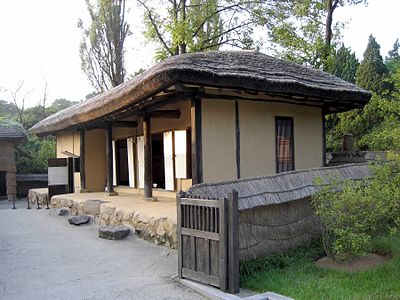
Search
Revolutionary Site

Revolutionary Sites (Korean: 혁명사적지) are designated historical sites in North Korea. The sites were designated by Kim Jong Il when he began working at the Propaganda and Agitation Department of the Workers' Party of Korea in 1966. He would send troops all over the country to unearth sites that "were supposedly once forgotten and undiscovered". By converting North Korea into a "huge open museum", Kim's goal in designating the sites was to solidify the North Korean cult of personality centered around him and his father Kim Il Sung.
In 1988, there were 27 such sites. Today, there are more than 60. Of them, 40 commemorate Kim Il Sung, 20 Kim Jong Il, and many others Kim Hyong-jik, Kim Jong-suk, Kim Hyong-gwon and other members of the Kim family.
There are two categories of sites, Revolutionary Sites and Revolutionary Battle Sites. Rather than a single building or a point of interest, the sites spawn large areas. Some famous Revolutionary Sites include Mangyongdae, the birthplace of Kim Il Sung, in Pyongyang, and Jangjasan Revolutionary Site and Oun Revolutionary Site associated with the youth of Kim Jong Il. The Mount Paektu area in particular hosts many sites.
South Koreans have criticized the sites for "wip[ing] out traditional culture".
List
Revolutionary Sites
Revolutionary Battle Sites
See also
- History of North Korea
- Korean independence movement
- List of museums in North Korea
- List of tourist attractions in Pyongyang
References
Works cited
- Corfield, Justin (2014a). "Changsan Revolutionary Site". Historical Dictionary of Pyongyang. London: Anthem Press. p. 26. ISBN 978-1-78308-341-1.
- — (2014b). "Chilgol Revolutionary Site". Historical Dictionary of Pyongyang. London: Anthem Press. pp. 27–29. ISBN 978-1-78308-341-1.
- — (2014c). "Kaeson Revolutionary Site". Historical Dictionary of Pyongyang. London: Anthem Press. pp. 72–73. ISBN 978-1-78308-341-1.
- — (2014d). "Ponghwa Revolutionary Site". Historical Dictionary of Pyongyang. London: Anthem Press. p. 164. ISBN 978-1-78308-341-1.
- Kim, Ilpyong J. (2003). "Revolutionary Historical Sites". Historical Dictionary of North Korea. Lanham: Scarecrow Press. pp. 112–113. ISBN 978-0-8108-4331-8.
External links
- Revolutionary Sites Archived 7 October 2018 at the Wayback Machine at korea-dpr.com
Text submitted to CC-BY-SA license. Source: Revolutionary Site by Wikipedia (Historical)
Owlapps.net - since 2012 - Les chouettes applications du hibou


